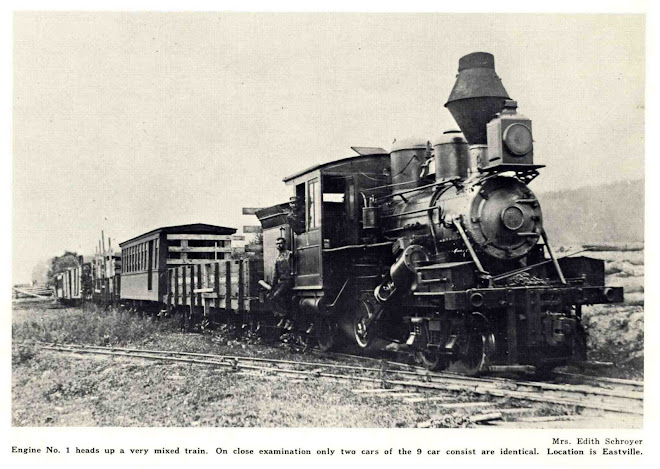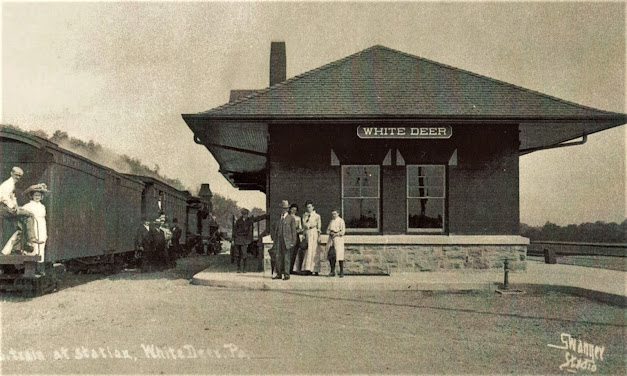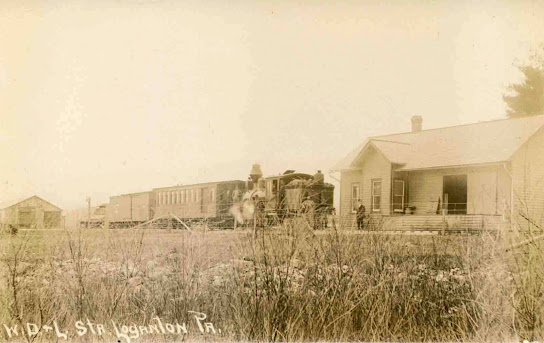The White Deer Train Station (RDG). When standing at the White Deer station, there are rails on both the right and the left. The rails on the right are from the (defunct) Reading Railroad. The tracks to the left were from the (defunct) White Deer & Loganton or W.D.&L. railway.
The White Deer Railroad was incorporated on April 7th 1864.
"The story of the narrow-gauge at White Deer goes back before the turn of the century. The Duncan Lumber Company in the nineties was cutting lumber in the vicinity of Paddy's Mountain in Mifflin County. The company operated a narrow-gauge railway, using wooden tracks, to haul the lumber out to the Pennsylvania Railroad at Paddy's Mountain station. When the supply of timber on this tract gradually declined, however, the Duncan Lumber Company, in March of 1899, transferred operations to White Deer village, across the Susquehanna River from Watsontown." - Narrow Gauge in Union County By Denney
"Lumbar baron John F. Duncan built a narrow gauge line to haul logs from the mountains of Clinton and Union Counties. The White Deer Valley Railroad was a logging line built in 1900 to haul logs between what is now Tea Springs and John Duncan's sawmill near White Deer (Union County)."
March 1901 - White Deer Valley To Duncan Station, 15 miles
When Duncan died in 1904, the railroad was purchased by William Whitmer and Sons. They formed the White Deer and Loganton Railway, establishing daily freight and passenger service between White Deer and Loganton. Whitmer and Sons later became the Whitmer-Steele Lumber Company.
================
The White Deer & Loganton Railway
=================
In April of 1906, the White Deer & Loganton Railway (WD&L) was established. This company was a separate entity from the White Deer Valley Railroad. New tracks were laid from Tea Springs to Loganton to complete the 23 mile line. The first train arrived in Loganton, Clinton County, on May 10, 1907
The mail carrier was John Bubb, known for his snowy white goatee. He used a wheelbarrow to card mail sacks back and forth between the Loganton train station and the post office located half a mile away.
The trains brought in coal, fertilizer, and merchandise. It exported lumber from a local sawmill.
The excursion cars were home built. The coaches may have come from a railroad in southeastern Pennsylvania. The train included a milk car, reefer, box cars and a caboose.
"Both passengers and freight were hauled by the little railroad. Connection to the outside world was at White Deer, where the railroad interchanged with the Reading Railroad at the station there. Motive power consisted of Climax- type steam locomotives. These engines were popular with logging companies for their power and ability to traverse rough track. Speed on the other hand, was anything but fast. For passenger service, one of the engines was re-geared to enable higher speeds for this purpose."
"The track was 24 and four tenths miles in length and ran from what is now Rte. 15 at White Deer to the crossroad in Loganton just north of the creek to the terminal station. It was truly a local, stopping at any semblance of a cross road. There were four locomotives; No. 1, No. 2, a third one, a duplicate of No. 2 and the so-called "Pot Engine." Later passenger service was added particularly for excursions to the Tea Spring. Regular railroad tickets were issued to patrons. In the years 1915 and 1916 negotiations were under way for the sale of the W.D. and L. R.R. to the brickyard at Watsontown. The last run was made May 31, 1916. Except for the road bed nothing remains of this activity." - Lock Haven Express, 1965
By 1914, most of the surrounding timber had been cut and automobiles were replacing the train as a mode of transportation. Owners of the line absorbed financial losses to keep the line open as a service to the residents of the Loganton area. Eventually, these losses could no longer be ignored. On May 31, 1916, the White Deer & Loganton Railroad closed and faded into history. The rails were quickly removed.
When the White Deer & Loganton dissolved, "The Pot", a locomotive so named for it's strange upright boiler, was sold to a brick plant in Watsontown.
The Reading passenger line continued to run until January of 1951, and the Reading freight service operated until August of 1976.
===========
WHITE DEER
TRAIN STATION
=================
The original train station at White Deer was built about 1872, when the Catawissa, Danville, and Milton line bridged the river at West Milton.. That station was destroyed by fire on October 9 1909, after the Reading had taken over the line. The current building was completed on July 21, 1910.
The White Deer Train station was placed on the National Register of Historic Places in 1976, and in 1978, the Central PA Chapter of the National Railway Historical Society purchased the station for $10,000. Today it is a museum, open to the public every Sunday afternoon spring through fall.
Find an Index of "Railroad Incidents" in the Susquehanna Valley here:
============
For More History & Stories From White Deer:
For More Local Stories & History From Nearby Towns
============
READ MORE
=============
A narrow-gauge railroad was con structed by the John F. Duncan Lumber Co. along the White
Deer Creek solely to facilitate the removal of timber from the nearby mountains. It was operated just as a logging railroad under private management.
NARROW-GAUGE RAILROADING IN
UNION COUNTY
BY JOHN D. DENNEY, JR. [1950}
The story of the narrow-gauge at White Deer goes back before
the turn of the century. The Duncan Lumber Company in the nineties was cutting lumber in the vicinity of Paddy's Mountain in Mifflin County. The company operated a narrow-gauge
railway, using wooden tracks, to haul the lumber out to the Pennsylvania Railroad at Paddy's Mountain station. When the supply of timber on this tract gradually declined, however, the Duncan Lumber Company, in March of 1899, transferred operations to White Deer village, across the Susquehanna River from Watsontown.
A narrow-gauge railroad was con structed by the John F. Duncan Lumber Co. along the White
Deer Creek solely to facilitate the removal of timber from the nearby mountains.
It was operated just as a logging railroad under private management.
After the untimely death of Mr. Duncan, however, the lumber
operations were sold out to the Whitmer-Steele lumber interests
at Sunbury, Pennsylvania. Then the narrow-gauge lumber railroad
at White Deer was incorporated as the "White Deer and Loganton
Railway," on April 17, 1906. The Duncan interests had operated
the road, which had been known as the White Deer Valley Railroad,
from White Deer into Duncan, some fifteen miles. The new
owners, during 1906 and 1907, extended the trackage from Duncan
to Loganton, Pennsylvania, twenty-four miles from White
Deer. The first narrow-gauge train ran from White Deer to
Loganton on May 1, 1907. The new operators of the road included
Charles Steele, president; Harry Steele, vice-president;
and Elmer Crissman as superintendent.
The new railroad meant much to the people of Loganton and
the area known as Sugar Valley. Prior to the coming of the
railroad, all supplies and merchandise had to be brought in over
the mountains by wagons from Lock Haven. The narrow-gauge
gave Loganton an outlet on the Williamsport-Shamokin line of
the Reading Railroad at White Deer. Thus these small railroads
played a great part in the development of the wilder, more remote sections of the state, before the coming of the automobile
and fine highways of the present day.
The Loganton narrow-gauge commenced right beside the Reading
station at White Deer. The three-foot-gauge tracks ran north
along the Reading for about one half mile to a point known as
White Deer Junction, before turning westward and heading into
the forests. The Reading agent at White Deer did all of the station
business for the W. D. & L., including the freight billing and the
ticket work. Of course, at White Deer, all shipments had to be
unloaded from the narrow-gauge cars and reloaded onto the
Reading Railroad cars. The narrow-gauge maintained a large
building at White Deer Junction, where the locomotives could be
stored when not in use, or where repairs could be made.
The section through which the little railroad operated was a
very scenic wooded area. The roadbed followed the White Deer
Creek, which was well known in Central Pennsylvania for its
"speckled" or brook trout. The timetable of the line showed such
stations as Clam Bake Springs, Lick Run, Mile Run, Zimmerman
(or Duncan), Tea Springs, Green's Gap and Carroll. Yet these
were only small "flag" stops, with little more than a waiting
place for the train. At the town of Loganton, the railroad maintained
its own station and an agent who handled the tickets,
freight billing and express business. There were also branches
built from the "main line" at Mile Run, Zimmerman's and Green's
Gap. These lines were used by the White Deer Lumber Company
in moving timber from the Nittany Mountains in that area.
When the railroad was first opened, there were two passenger
trains a day into Loganton. After about two years, however, this
schedule was changed to one train a day for passengers. It took two
hours and twenty minutes for the train to creep over the twentyfour
miles of thirty-pound narrow-gauge rails. Trains usually
stopped at the station of Tea Springs to take water. Although there
was only one passenger schedule operated, there were two log trains
operated on an irregular schedule by the White Deer Lumber
Company. A heavy tonnage of white and yellow pine lumber was
taken out of that area yearly. The White Deer and Loganton and
the White Deer Lumber Company were controlled by the same
interests. Therefore the line was built much on the style of a
lumber railroad, with light rails and not too much heavy grading.
Four rather unique locomotives were used on the line, although
only two actually carried the lettering, "White Deer and
Loganton Railway." These two engines were numbered "one" and
"two" and were of the Climax, or geared type. This type of locomotive
was built by the old Climax Manufacturing Company of
Corry, and was the outcome of a demand for an engine with
great traction power and flexibility, for use on light, cheaply constructed
track. They could burn either wood or coal for fuel, were
equipped with large stacks, and carried the large, square, oil-burning
headlights. Now, engines "three" and "four" were owned by
the White Deer Lumber Company. The "three" was similar to
"one" and "two," but "engine four" was really an oddity.
"Engine four" was known as the "boxcar" locomotive. Technically,
it was known as a verticle-boilered Climax, built by the
company at Corry. The frame of the engine was just like a box
car with the boiler in a verticle position, with the pistons and
other parts of the engine several feet to the left. The coal box
was at one end of the locomotive while the water tank was at
the other end. These locomotives were rather light but, nevertheless,
they were powerful on the steep grades that were often found
on lumber railroads. Engines of the type could be even operated
on wooden rails or log "pole" roads if necessary. The four engines
were interchanged between the logging railroad of the White
Deer Lumber Company and the line of the W. D. & L., although
the box-car engine was maintained primarily for negotiating the
steep grades and the sharp curves on the various lumber operations.
It had originally been brought from the Duncan lumber company
over at Paddy's Mountain.
Nevertheless, the White Deer and Loganton had its share of
passenger business. The company had four passenger cars. One
was a regular type passenger coach while the other was a combination,
passenger and baggage. They were built by an eastern
manufacturer. These cars had narrow treads on the wheels and
low flanges and thus gave quite a bit of trouble, making it difficult
to keep the cars on the tracks. Then the company carpenters
were put to work and they turned out a home-made coach, a
milk-express car, and an open excursion car for summer use. These
had wheels with wide treads and high flanges similar to wheels
on log cars and were more satisfactory. Excursions and specials
were operated to Tea Springs, a pretty picnic spot in the woods,
where there was a pavilion and facilities for outings, dances and
picnic gatherings. The village of Loganton and the various lumber
camps also were sources of passenger revenue. Then, too, the
American Express Company transacted business over the narrow-
gauge.
Sources:
WHITE DEER AND LOGANTON RAILWAY:
- Correspondence and Interviews: W. W. Campbell, Northumberland, Pa.,
- former Reading agent at White Deer, son of former W. D. & L. engineer;
- Charles Steele, Northumberland, Pa., owner of the W. D. & L.; Mrs. Walter
- Sheltman, West Milton, Pa., family connected with the lumber operations
- at White Deer; Lewis Wilkins, White Deer, Pa., former engineer.
- Publications: White Deer and Loganton Timetable, effect July 6, 1915;
- Poor's and Moody's Manuals of Railroads































Thank you for the wonderful article on this spectacular little railway. I wish someone had written a book on it.
ReplyDeleteanyone have any pictures of the picinic area at tea springs, would like to run the metal detector around the area
ReplyDelete